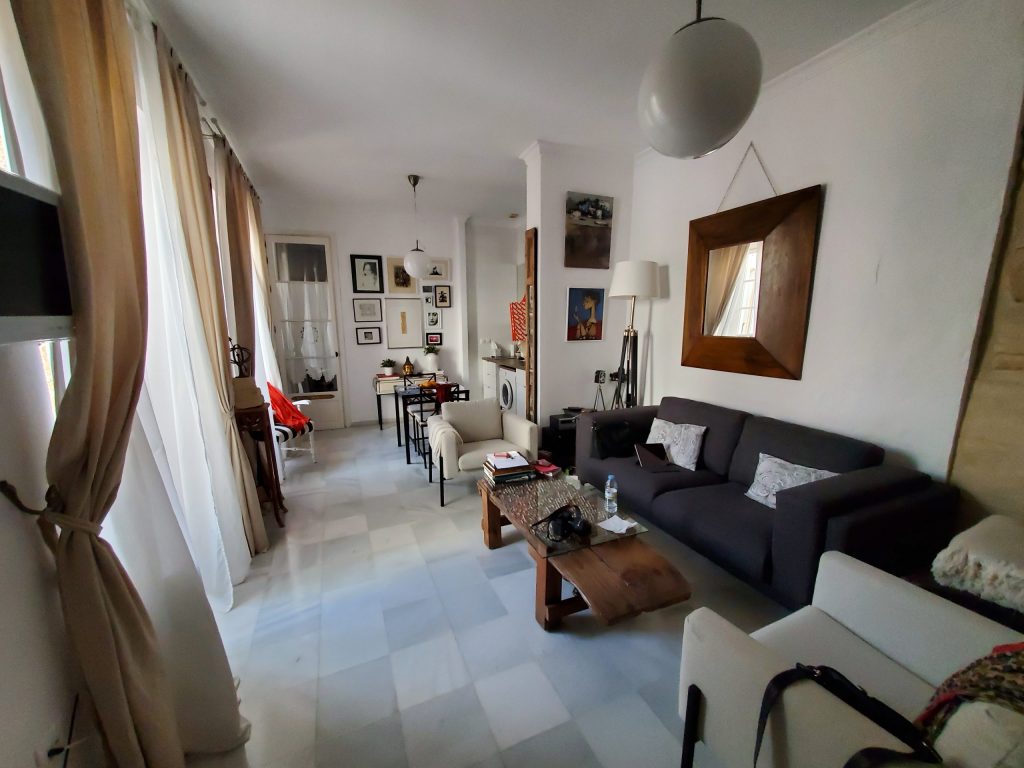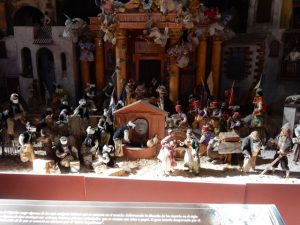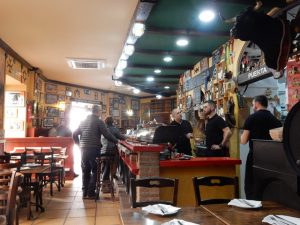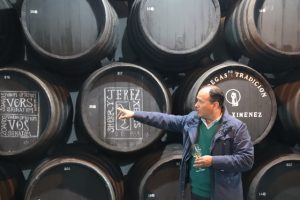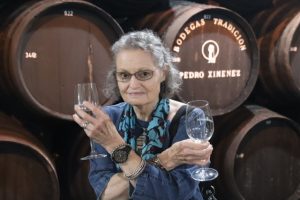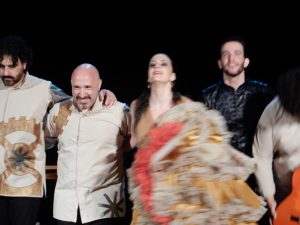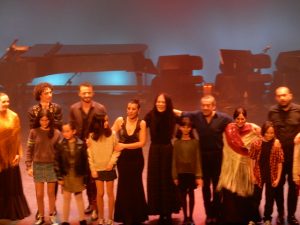Reminder to self: despite the nice weather, it is still winter in Jerez. We had been lulled into thinking the great weather would last forever, but Tuesday was a minor wake-up.
When we checked the weather, it was colder than it had been and, supposedly, foggy. No sign of fog or the predicted showers, but it was cool and breezy most of the day. We ate breakfast outside, but it was really too cool to be comfortable. Besides, Patricia didn’t agree with my choice of a cafeteria that served coffee that wasn’t particularly good and didn’t have the right kind of mollete on offer. A mollete is a small loaf of bread cut horizontally and served with olive oil, tomato , jamón (ham), and other toppings. Very popular here and inexpensive, too. They are a favorite of Patricia’s at home and here, so she has actual standards, where I just take what comes.
We visited the Cathedral of Jerez, something we hadn’t done in previous visits. Big surprise: when the Catholics reclaimed Jerez from the Moors, they re-worked the mosque on this site into a church before tearing it down and rebuilding. The present cathedral was finished in the 17th century, but it took so long to build that it is a mixture of Gothic, Renaissance, and Baroque styles. On the outside it has flying buttresses and on the inside there are 4 aisles and a dome over the center transept. Unlike many of the churches we have visited, this one did not have a lot of side chapels. In fact, the decorations (probably not the right word) were fairly sparse. There were few statues and paintings. The stained glass, which was all very high on the walls, was nice, but fairly small. I suspect that even at the late date of its construction, the art of making large windows in the main walls wasn’t well-developed here in Jerez.
There are quite a few small rooms around the perimeter of the church, so we saw several exhibits, most of which were related to church life. The exhibit(?) which most captured our imagination was a nativity scene, but it wasn’t just any nativity scene. This one had dozens of articulated mannequins dressed in silks and paper garments created in the 1600s. It came from Italy and was very impressive in its details. [See the pictures.]
You can see how our days get filled up. As soon as we left the cathedral, we walked up to another church—San Miguel—to check out when it was open. Then we walked around the corner to Las Banderillas, the tabanco that is close to our apartment. We had some tapas—which Patricia insists I could not call “lunch”—before making a quick stop at the apartment and heading for our next outing.
We hiked to Bodegas Tradición for a tour. I say “hiked” because it is uphill from our apartment and about 20 minutes away. I should point out that the “hills” in Jerez are nothing like even the flattest of streets in Seattle. Bodegas Tradición was started in 1998, so you might think that the “traditional” in the name is ironic, but it is not. It was started by a member of a Jerez wine-making family that goes back to the 1600s. It is dedicated to making small quantities of very high quality, aged sherrys. It is unique in that it also houses a private art collection of the highest quality. The collection includes Goyas, el Ggrecos, Zurburáns, and Picassos. There were 6 of us on the tour, which was given in English. We learned a lot about the art collection and the sherry making process. Tradición is a relatively small bodega and it is all about quality and making sherry the “right” way, which is mostly by hand. We got to walk through the rooms where the sherry casks are stored and every once in a while we would stop in front of a cask which had the notes for the tour written on it in chalk. We also got a comparative history of how the sherry industry changed from hundreds of years ago to when the British industrialized it and how it is, in some cases, moving back to a more personal business. It should be pointed out, though, that the sherrys from places like Bodegas Tradición are far mor expensive than mass-produced sherrys. [Interesting side note: the plural of sherry can be either sherry or sherries. It can be countable or not. I chose “sherrys” because I was talking about the classes of sherry wine.]
On top of the tour, we sampled a number of very good sherries. During the first part of the tour while were in the gallery our guide would place us in front of a picture and “pair” it with an appropriate sherry. Very civilized, I must say. Near the end of the tour, the seven of us sat around a table, sipped more sherry, sampled some tapas, and talked about football (soccer).
We attended two flamenco performances Tuesday evening. The first, at Sala Compañia, was called TEMPUs [sic] (like “time”) by Luisa Palacio. Some might call the performance avant-garde and it probably was, but I hardly noticed. What I first noticed when the curtain rose was a set decorated with lots of timepieces and symbols related to time. Then, I saw a piano! Oh, no! How can this be flamenco? If my Spanish was better, I could probably tell you the story, but the best I can do is to say that while “time” played a part, what was thrilling (yes, I wrote “thrilling”) was the emotion (duende) evoked by the dance, song, and music. Luisa Palacio was strong and graceful and evoked a range of emotions. Ana Gómez has a voice that filled up the venue and could fill up, I am sure, a football stadium. What power—in all senses. Alejandro Rodríguez, a dancer, filled the role of a sort of “agent of time” was all over (and off) the stage move the story forward. We were so impressed.
I have just discovered that there is already a video and review of the performance at www.deflamenco.com/revista/resenas-actuaciones/obras-de-shoji-kojima-y-luisa-palacio-cargadas-de-simbolismo.html. While I didn’t discover it until today, apparently there is a review and usually a video of festival performances posted just hours after the performances. I will try not to crib from the reviews.
It was a short walk back to Villamarta for our 9:00 espectáculo but like all our walks on Tuesday, it was a bit windy and cold. In fact, it even felt cold in the theater. We saw another difficult-to-describe performance called Lorca X Bach. Lorca was a much revered and honored Spanish poet. Bach, of course, you know. The compañía of Shoji Kojima had a three part presentation. In the first part they combined Bach’s music with Lorca’s poetry through dance. [What a pathetic way to describe something truly unusual and original.] Think of the rhythm of poetry layered on Bach’s music, played on a piano and cello, accompanied by dancers whose motions combined the poetry and music.
In the second part Bach’s baroque music (dances forms) would start a piece and dancers would be doing baroque steps. The music would then transform in to flamenco palos (styles) and so would the dance. The cello was combined with cante, palmas, and percussion to complete the transformation. If you like Bach (I do) and if you like flamenco (I do) then you would be enthralled.
The third part was devoted to Shoji Kojima’s interpretation of cante jondo (deep, pure flamenco song) and the intersection of Lorca and Bach.
The dance in this espectáculo was a mixture of ballet, modern, and flamenco. The music, too, was a mix. It all came together in a very pleasing way. Here is a link to a video of parts of the performance: www.deflamenco.com/revista/canal-video/video-lorca-y-bach-shoji-kojima-festival-de-jerez.html.
